Have you taught a course on The Book?
We'd love to learn about it! Tell us about your course, and we will add it to our archive of Book Studies courses that have been taught at Indiana University, Bloomington.
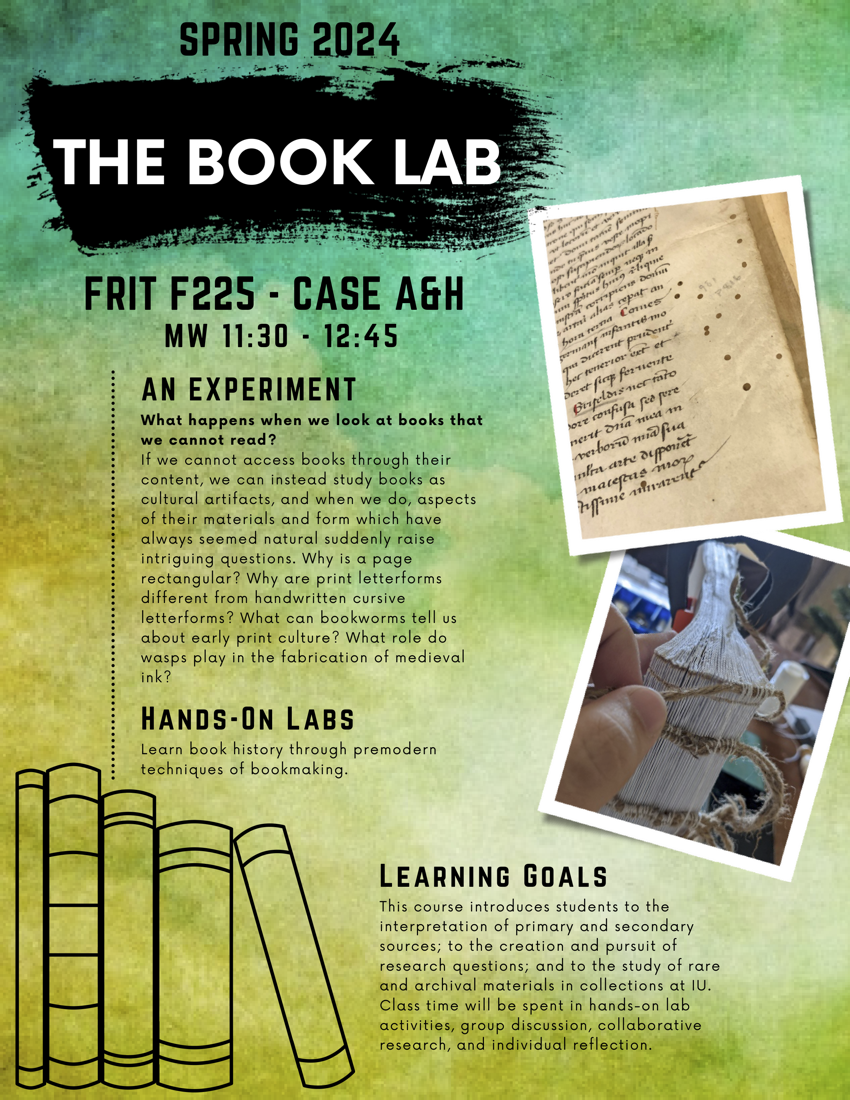
FRIT-F 225 Spring 2024 TAUGHT BY ELIZABETH HEBBARD ASURE PROGRAM COURSE
This course proposes an experiment: what happens when we look at books that we cannot read? If we can no longer access books through their content, we can instead study books as cultural artifacts, and when we do, aspects of their materials and form which have always seemed natural suddenly raise intriguing questions. Why is a page rectangular? Why are print letterforms different from handwritten cursive letterforms? These lead us to other questions about the book and the natural world: what can bookworms tell us about early print culture? What role do wasps play in the fabrication of medieval ink?
Our main focus will be looking deeply at early books, experimenting with making parts of them, and analyzing what we find through collaborative and creative projects. This course introduces students to the interpretation of primary and secondary sources; to the creation and pursuit of research questions; and to the study of rare and archival materials. Class time will be spent in lecture, hands-on lab activities, group discussion, collaborative research, and individual reflection.
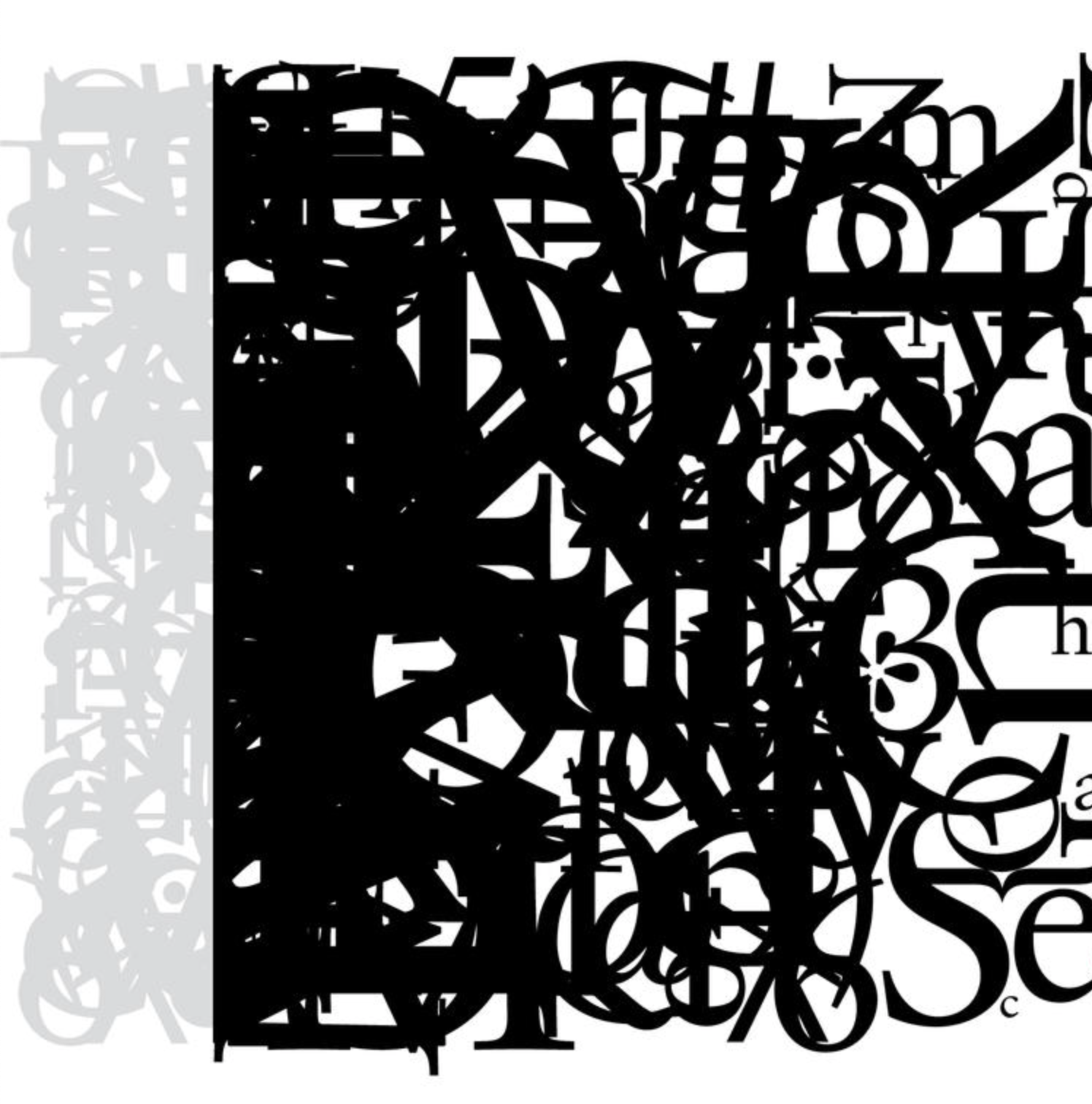
ENG-L 504 Fall 2024 TAUGHT BY PATRICIA INGHAM
Throughout the recent history of Higher Education, the lab model has been almost exclusively identified with research techniques in the sciences. And yet, in the early decades of the 20th century, John Matthews Manley (scholar of the literary works of Chaucer and medieval authors and early president of the Modern Language Association) and Edith Rickert (scholar of texts of Chaucer and medieval romance) collaborated at the University of Chicago on “The Chaucer Laboratory,” a collaborative research center dedicated to the production of scholarly editions of Chaucer’s corpus and other key medieval texts. On the one hand, this example urges attention to the long history of collaborative research methodologies in medieval studies; on the other hand, it suggests an exemplary model that might extend beyond the specificities of Chaucer, and help us to consider the power, pleasures, and politics of collaboration of the kind now again in vogue in all kinds of humanities fields.
In this course we will engage the lab model for work in Book History and Book Arts. We will 1) think methodologically about the uses of the ‘lab’ for Humanities Research and Teaching, reading some recent work on its uses in media studies, digital humanities, and elsewhere. What features of early humanities laboratories might we revive or redirect? What liabilities to the lab model are legible either from the example of the Chaucer Laboratory, or in other examples today? 2) But our primary focus will be on the material book, its history and the current efflorescence of homemade books and private presses. And we will, explicitly, draw on the capacities available via IUB’s ‘Book Lab’ to experiment with how immersive experiences might fuel research and making.
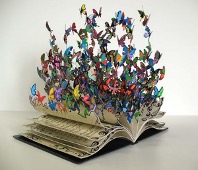
ENG-L 208 SPRING 2025 TAUGHT BY PATRICIA INGHAM ASURE PROGRAM COURSE
This ASURE Lab course focuses attention on all things Book: the book as object, as content, as interface with readers, and as idea. Students will study aspects of the history of books—from manuscripts to print and beyond-- and will experiment with the processes that go into book production. Come learn about the various histories and ecologies of books! Experiment with designing, planning, and making a book of your own.
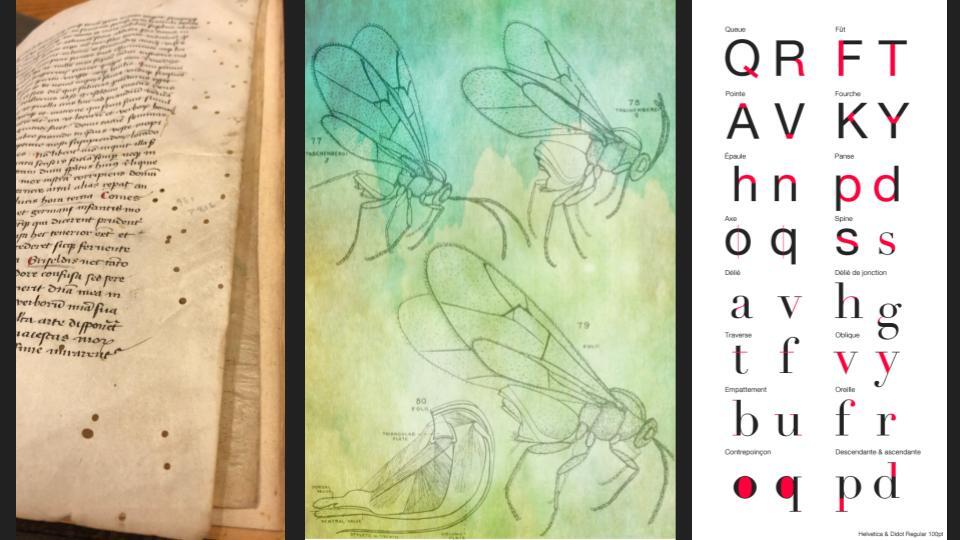
COLL-S 103 FALL 2023 TAUGHT BY ELIZABETH HEBBARD
Books are one of the most ordinary and familiar objects in our lives. We see them everywhere without ever really looking at them. We tend to think of books as simple containers of words and of works that can be accessed in a variety of formats: in print or in e-book, in disembodied PDF scans, or in fragmented GoogleBooks search results. Yet the book as object represents a realm of continual technological and artistic experimentation. Even today, the material existence of books runs the gamut from highly centralized and commercialized machine production to idiosyncratic handwritten memento. Books are sites of constant play between tradition and innovation, and over their long history, books have much to tell us beyond the words they transmit, especially about ourselves and our place in the natural world.
Our main focus in Ad Fontes will be looking deeply at early books, and we will be using computers to help us observe and analyze what we find: to store our data, to identify patterns in our data, to map our data onto geographical spaces, and to complete a collaborative creative project: generating new digital fonts based on historic typefaces. This course introduces students to the interpretation of primary and secondary sources; to the creation and pursuit of research questions; and to the study of rare and archival materials in collections at IUB. Class time will be spent in lecture, hands-on lab activities, group discussion, collaborative research, and individual reflection.

ENG-L 208 SPRING 2022 TAUGHT BY PATRICIA INGHAM ASURE PROGRAM COURSE
Throughout its long history, the book as a form combines useable and beautiful. As an easy container of words, the book (or codex) made stories both durable and portable. Books could outlast speeches; they could be put in a pocket, traded, exchanged, and taken on trips. Books were, of course, hand-crafted before they were mass-produced. But whether hand-made, printed, or digitized, books had first to be designed: calligraphers, designers of fonts and typefaces worked with rubricators, decorators, or illustrators to figure out the best, most beautiful or attractive way to package the stories, or histories, or poems they published. And books came in different sizes and shapes, miniature or gigantic, pop-up or flat, all organized for different purposes.
In this class students will be introduced to varying features of book design, with attention to specific examples. Some of this work will be inductive, assisting students in asking questions about features of books that they take for granted: What is the benefit of an index and what makes for a better or worse one? When did the “table of contents” become a thing? How much illustration is too much? What’s the most attractive font for a buff-colored page? How might inventive page layout (in, say, children’s pop-up books) fundamentally change the reader’s experience in a way that can’t be duplicated in digital form? How does block printing work? What do we know of the history of ink, for printing and in manuscript? Why did fore-edge painting go out of style? What’s the difference between a book designed for show and one designed to be easily movable?
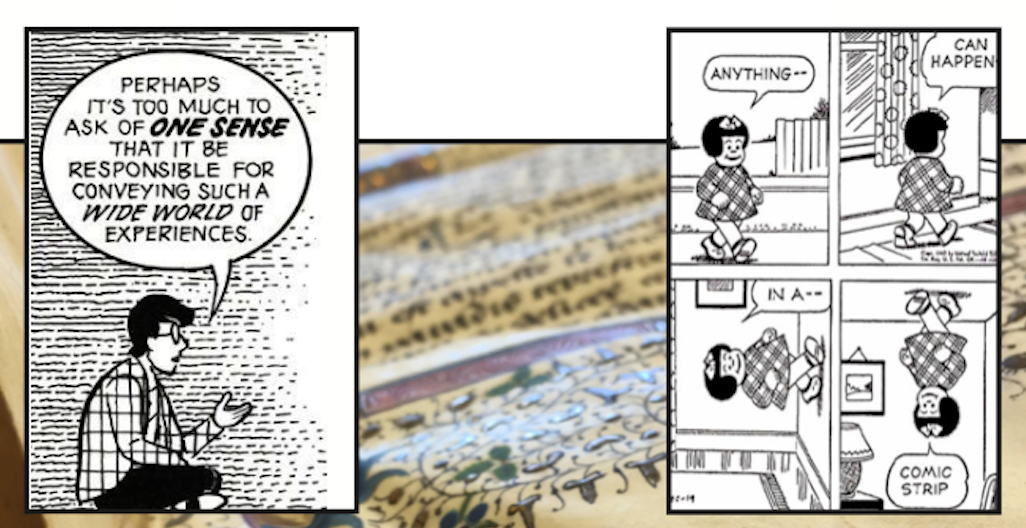
SPRING 2021 CLLC-L 110 TAUGHT BY KAYLA LUNT
How does being bound up in a book change how we interact with an image? What do comics have to do with medieval manuscripts? What are books, anyway? To what extent does the medium really affect the message?
In this course, we will analyze multimodal texts that combine written and visual expressions, focusing on books and bookish objects: medieval manuscripts, children’s books, comics and graphic novels, artists’ books, and even a variety of digital “books.” Students will engage with foundational theories of looking and reading, developing the ability to describe how an object informs the reception of the images and written texts it transmits. We will work directly with objects in special collections across campus and students will put their knowledge and experiences into practice with a final project that, at their choice, can take the form of a research paper, a "visual argument," or the creation of their own bookish object.
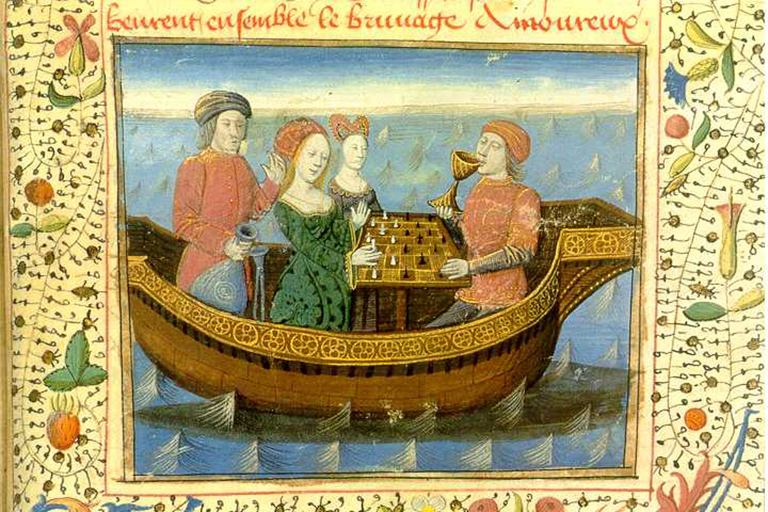
FALL 2019 FRIT-F 615/MEST-M 600 TAUGHT BY ELIZABETH HEBBARD
The medieval manuscript is a witness to unique versions of texts, a cultural artifact with an idiosyncratic logic and unique history. This seminar initiates students in the main fields of manuscript studies (paleography and codicology) as well as early book history and textual scholarship. Our approach privileges hands-on experiences in the Lilly Library, but prepares students for archival work of all kinds. Exercises offer students the opportunity to confront and manipulate manuscripts in person and via cutting edge digital viewers and transcription/annotation tools. Course readings and activities examine the medieval book in its own right, as well as considering books as cultural objects and bringing books into dialogue with current theory, including animal studies, environmental studies and ecocriticism, object-oriented ontology, gender studies, and digital humanities. We will focus predominantly on manuscripts produced in the Latin West, with comparative discussion of contemporary Hebrew, Arabic, Persian, and Ethiopic materials. Our work will also concern mainly the manuscript codex, though some attention will also be paid to manuscript texts in other formats. Fluent reading knowledge of Latin is not necessary but basic knowledge of Latin is strongly recommended. Students are encouraged and expected to collaborate and share their language expertise.
We'd love to learn about it! Tell us about your course, and we will add it to our archive of Book Studies courses that have been taught at Indiana University, Bloomington.